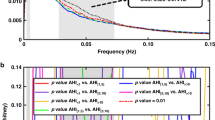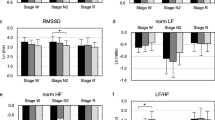Abstract
Background
The low- to high-frequency components ratio (LF/HF) of heart rate variability reflects the balance between sympathetic and parasympathetic activity. The autonomic response in individuals with obstructive sleep apnea (OSA) may lead to sympathetic activation demonstrated by an increase in the LF/HF ratio. Studies examining autonomic function during sleep and wake in children with OSA are relatively scarce.
Aim
A meta-analysis of the relevant available publications.
Methods
A MEDLINE search from 2000 through 2013 at PubMed (NLM) was performed. A search for the index terms (“sleep disordered breathing” OR “obstructive sleep apnea”) AND “heart rate” in all fields was done. Studies that included comparisons between children with and without diagnosed OSA were included into the analysis. Types of “outcome measures” were the values of the LF/HF indices in different states of the sleep–wake cycle.
Results
Four studies met the inclusion criteria. A total of 518 control children and 272 children with different degrees of OSA whose mean age ranged between 4.2 and 9.8 years were reported in the studies. Large inconsistencies concerning the effect sizes across publications were found. Meta-regression revealed a statistically significant association between calculated values of the effect sizes and the reported mean values of the apnea–hypopnea indices in the OSA groups (intercept: − 0.11826, regression coefficient: 0.01667, p = 0.048).
Conclusion
Power analysis of heart rate variability in children with OSA may help to provide further information regarding neural control mechanisms that are altered in OSA. The LF/HF index may serve as an indicator of OSA severity and as a possible marker for risk stratification in children with OSA.
Zusammenfassung
Hintergrund
Das Verhältnis der Niedrig- zu den Hochfrequenzkomponenten („low frequency“/„high frequency“, LF/HF) der Herzfrequenzvariabilität spiegelt das Gleichgewicht zwischen Sympathikus- und Parasympathikusaktivität wider. Die autonome Reaktion bei Personen mit obstruktiver Schlafapnoe (OSA) kann zur Sympathikusaktivierung führen, was sich an einem Anstieg des LF-HF-Quotienten zeigt. Studien zur autonomen Funktion im Schlafen und Wachen bei Kindern mit OSA sind relativ selten.
Ziel
Ziel war eine Metaanalyse der relevanten verfügbaren Publikationen.
Methoden
Eine Suche in MEDLINE von 2000 bis einschließlich 2013 wurde mittels PubMed (NLM, National Library of Medicine) durchgeführt. Dabei erfolgte die Suche nach folgenden Indexbegriffen: „sleep disordered breathing“ OR „obstructive sleep apnea“ und in sämtlichen Feldern: AND „heart rate“. Studien mit Vergleichen zwischen Kindern mit und ohne Diagnose einer OSA wurden in die Auswertung aufgenommen. Als Endpunktparameter waren die Werte der LF-HF-Quotienten in verschiedenen Stadien des Schlaf-Wach-Zyklus maßgeblich.
Ergebnisse
Die Einschlusskriterien wurden von 4 Studien erfüllt. In den Studien wurde über 518 Kinder als Kontrollen und 272 Kinder mit verschiedenen Graden der OSA berichtet, das Alter lag zwischen 4,2 und 9,8 Jahren. Es wurde erhebliche Inkonsistenzen in Bezug auf die Effektstärken bei den Publikationen festgestellt. Die Metaregression ergab einen statistisch signifikanten Zusammenhang zwischen den berechneten Werten der Effektstärken und den dokumentierten Mittelwerten der Apnoe-Hypopnoe-Indizes in der OSA-Gruppe (Intercept: − 0,11826; Regressionskoeffizient: 0,01667; p = 0,048).
Schlussfolgerung
Die Power-Spektrum-Analyse der Herzfrequenzvariabilität bei Kindern mit OSA kann dazu beitragen, weitere Informationen zu neuralen Kontrollmechanismen zu liefern, die bei OSA verändert sind. Der LF-HF-Quotient dient möglicherweise als Indikator des Schweregrads der OSA und als möglicher Marker zur Risikostratifizierung bei Kindern mit OSA.

Similar content being viewed by others
References
American Academy of Pediatrics (2002) Clinical practice guideline: diagnosis and management of childhood obstructive sleep apnea syndrome. Pediatrics 109:704–712
American Thoracic Society (1996) Standards and indications for cardiopulmonary sleep studies in children. Am J Respir Crit Care Med 153:866–878
Anonymous (1996) Heart rate variability: standards of measurement, physiological interpretation and clinical use. Task Force of the European Society of Cardiology and the North American Society of Pacing and Electrophysiology. Circulation 93:1043–1065
Baharav A, Kotagal S, Gibbons V et al (1995) Fluctuations in autonomic nervous activity during sleep displayed by power spectrum analysis of heart rate variability. Neurology 45:1183–1187
Baharav A, Kotagal S, Rubin BK et al (1999) Autonomic cardiovascular control in children with obstructive sleep apnea. Clin Auton Res 9:345–351
Berry RB (2012) Fundamentals of sleep medicine. Elsevier, Philadelphia
Bonnet MH, Arand DL (1997) Heart rate variability: sleep stage, time of night, and arousal influences. Electroencephalogr Clin Neurophysiol 102:390–396
Borenstein M, Hedges L, Higgins J, Rothstein H (2005) Comprehensive meta-analysis version 2. Biostat, Englewood
Borenstein M, Hedges LV, Higgins JPT, Rothstein HR (2009) Introduction to meta-analysis. Wiley, Chichester
Busek P, Vankova J, Opavsky J et al (2005) Spectral analysis of the heart rate variability in sleep. Physiol Res 54:369–376
Carlson JT, Hedner J, Elam M et al (1993) Augmented resting sympathetic activity in awake patients with obstructive sleep apnea. Chest 103:1763–1768
Cohen BH, Lea RB (2004) Essentials of statistics for the social and behavioral sciences. Wiley, Hoboken
Guilleminault C, Connolly S, Winkle R et al (1984) Cyclical variation of the heart rate in sleep apnoea syndrome. Mechanisms, and usefulness of 24 h electrocardiography as a screening technique. Lancet 1:126–131
Gula LJ, Krahn AD, Skanes A et al (2003) Heart rate variability in obstructive sleep apnea: a prospective study and frequency domain analysis. Ann Noninvasive Electrocardiol 8:144–149
Jo JA, Blasi A, Valladares E et al (2005) Determinants of heart rate variability in obstructive sleep apnea syndrome during wakefulness and sleep. Am J Physiol Heart Circ Physiol 288:H1103–H1112
Kesek M, Franklin KA, Sahlin C, Lindberg E (2009) Heart rate variability during sleep and sleep apnoea in a population based study of 387 women. Clin Physiol Funct Imaging 29:309–315
Khoo MC, Kim TS, Berry RB (1999) Spectral indices of cardiac autonomic function in obstructive sleep apnea. Sleep 22:443–451
Lanfranchi PA, Somers VK (2011) Cardiovascular physiology: autonomic control in health and in sleep disorders. In: Kryger MH, Roth T, Dement WC (eds) Principles and practice of sleep medicine. Saunders, Philadelphia, pp 226–236
Liao D, Li X, Vgontzas AN et al (2010) Sleep-disordered breathing in children is associated with impairment of sleep stage-specific shift of cardiac autonomic modulation. J Sleep Res 19:358–365
Malliani A (2005) Heart rate variability: from bench to bedside. Eur J Intern Med 16:12–20
McNicholas WT, Bonsigore MR, Management Committee of ECAB (2007) Sleep apnoea as an independent risk factor for cardiovascular disease: current evidence, basic mechanisms and research priorities. Eur Respir J29:156–178
Muzumdar HV, Sin S, Nikova M et al (2011) Changes in heart rate variability after adenotonsillectomy in children with obstructive sleep apnea. Chest 139:1050–1059
Narkiewicz K, Montano N, Cogliati C et al (1998) Altered cardiovascular variability in obstructive sleep apnea. Circulation 98:1071–1077
Narkiewicz K, Somers VK (2001) Cardiovascular variability characteristics in obstructive sleep apnea. Auton Neurosci 90:89–94
Narkiewicz K, Somers VK (2003) Sympathetic nerve activity in obstructive sleep apnoea. Acta Physiol Scand 177:385–390
Nisbet LC, Yiallourou SR, Nixon GM et al (2013) Nocturnal autonomic function in preschool children with sleep-disordered breathing. Sleep Med 14:1310–1316
Parish JM, Somers VK (2004) Obstructive sleep apnea and cardiovascular disease. Mayo Clin Proc 79:1036–1046
Park DH, Shin CJ, Hong SC et al (2008) Correlation between the severity of obstructive sleep apnea and heart rate variability indices. J Korean Med Sci 23:226–231
Penzel T (2003) Is heart rate variability the simple solution to diagnose sleep apnoea? Eur Respir J 22:870–871
Penzel T, Glos M, Schobel C et al (2013) Estimating sleep disordered breathing based on heart rate analysis. Conf Proc IEEE Eng Med Biol Soc 2013:6571–6574
Pumprla J, Howorka K, Groves D et al (2002) Functional assessment of heart rate variability: physiological basis and practical applications. Int J Cardiol 84:1–14
Smietanowski M, Szelenberger W, Trzebski A (2006) Nonlinear dynamics of the cardiovascular parameters in sleep and sleep apnea. In memory of Alberto Malliani (1935–2006)—a brave heart and beautiful mind. J Physiol Pharmacol 57 Suppl 11:55–68
Smith RP, Veale D, Pepin JL, Levy PA (1998) Obstructive sleep apnoea and the autonomic nervous system. Sleep Med Rev 2:69–92
Somers VK, Dyken ME, Clary MP, Abboud FM (1995) Sympathetic neural mechanisms in obstructive sleep apnea. J Clin Invest 96:1897–1904
Somers VK, White DP, Amin R et al (2008) Sleep apnea and cardiovascular disease. Circulation 118:1080–1111
Spruyt K (2012) Pediatric sleep-disordered breathing: criteria and spectrum of disease. In: Kheirandish-Gozal L, Gozal D (eds) Sleep disordered breathing in children: a comprehensive clinical guide to evaluation and treatment. Humana Press, New York, pp 245–260
Vanninen E, Tuunainen A, Kansanen M et al (1996) Cardiac sympathovagal balance during sleep apnea episodes. Clin Physiol 16:209–216
Vaughn BV, Quint SR, Messenheimer JA, Robertson KR (1995) Heart period variability in sleep. Electroencephalography and clinical neurophysiology 94:155–162
Verrier RL, Harper RM (2011) Cardiovascular physiology: central and autonomic regulation. In: Kryger MH, Roth T, Dement WC (eds) Principles and practice of sleep medicine. Saunders, Philadelphia, pp 215–225
Walter LM, Nixon GM, Davey MJ et al (2013) Autonomic dysfunction in children with sleep disordered breathing. Sleep Breath 17:605–613
Wang W, Tretriluxana S, Redline S et al (2008) Association of cardiac autonomic function measures with severity of sleep-disordered breathing in a community-based sample. J Sleep Res 17:251–262
Weller D, Paditz E, Rüdiger H et al (2006) Veränderung der Herzfrequenzvariabilität, der Blutdruckvariabilität und der Baroreflexsensitivität tagsüber und im Schlaf bei Kindern mit obstruktivem Schlafapnoesyndrom. Somnologie 10:130–137
Compliance with ethical guidelines
Conflict of interest. I.A. Kelmanson states that there are no conflicts of interest. This manuscript does not include studies on humans or animals.
Author information
Authors and Affiliations
Corresponding author
Rights and permissions
About this article
Cite this article
Kelmanson, I. Signs of sympathetic dominance in sleep and wake based on spectral analysis of heart rate variability in children with obstructive sleep apnea. Somnologie 18, 194–201 (2014). https://doi.org/10.1007/s11818-014-0672-y
Received:
Accepted:
Published:
Issue Date:
DOI: https://doi.org/10.1007/s11818-014-0672-y
Keywords
- Cardiac autonomic modulation
- Sleep–wake cycle disorders
- Heart rate variability
- Sleep apnea syndromes
- Power spectrum analysis




